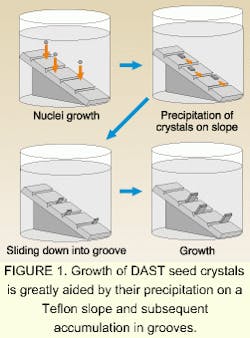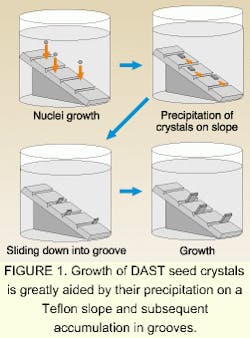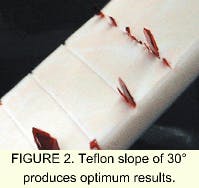NONLINEAR MATERIALS: Slope aids in crystal growth
OSAKAA research group led by Prof. Takatomo Sasaki at Osaka University has developed a method of growing an organic optical nonlinear crystal called DAST (4-dimethylamino-N-methyl-4-stilbazolium). The material has superior nonlinear optical properties. Anticipated applications include optical sampling of high-speed signals for communications, production of terahertz-region electromagnetic waves using difference-frequency mixing, and the diagnosis of quantum circuits.
For practical use, it is necessary to create large crystals that can be processed using techniques such as polishing and cutting. Organic crystals are superior to inorganic crystals in terms of nonlinear optical effects and reaction time of the electrons, but they are generally not as hard as inorganic crystals and are thus more difficult to work with; in addition, there have been problems with durability. However, DAST crystals have the property of increasing in hardness as the molecules orient themselves during working, giving hope that the crystals can be used in practical applications.
The group has succeeded in creating the requisite seed crystal for eventual large crystal growth. A sloping surface made of Teflon is placed in a DAST solution, causing spontaneous nuclei to precipitate onto the Teflon in the form of microcrystals. Eventually, the precipitated microcrystals slide down the slope into a groove and settle with the DAST(001) surface in the vertical direction. The temperature is lowered and the crystal grown (see Fig. 1).
Crystal growth occurs only within the groove, preventing polycrystallization. Because the crystal is grown vertically so that the flat crystal has the DAST(001) face in the vertical direction, crystallinity is enhanced.
The crystal is grown at a slope of 30°, groove depth of 0.5 mm, and groove width of 0.5 mm (see Fig. 2). According to (001) surface x-ray diffraction analysis, the molecular orientation of the DAST(001) surface has a half-width distribution from 20.2 to 57.6 arc sec. This is about half that achieved when the slope is not used for the growth process. The electric-field sensing characteristics are four times better than they are in the inorganic crystal KTP (potassium titanyl phosphate).
Courtesy O plus E magazine, Tokyo


